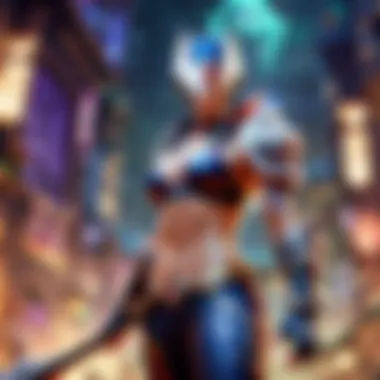Understanding and Developing a Play Brand in League of Legends


Intro
In recent years, the concept of a play brand has gained significance, especially in gaming communities. League of Legends, known for its competitive ecosystem, serves as an ideal backdrop to explore this topic. Establishing a unique identity within this space is crucial for both individual players and creators.
The essence of a play brand goes beyond mere recognition; it involves creating an engaging presence that resonates with the community. This article aims to dissect the various elements that contribute to a robust play brand, emphasizing brand strategy, community engagement, and the impact of esports. By delving into these aspects, we seek to equip players and innovators with actionable insights to enhance their standing in the League of Legends arena.
Champion Spotlights
New Champion Spotlight
New champions are a vital part of the League of Legends experience. When a new champion is released, it presents not only fresh gameplay mechanics but also an opportunity for players to adapt their play brands. An in-depth analysis of new champions can reveal advantages that players can leverage to differentiate themselves.
Champion Builds and Strategies
Focusing on effective builds and strategies for popular champions is essential. These methods can form the backbone of a player’s identity within the game. By understanding the optimal ways to play champions such as Ahri or Jhin, players can create a distinctive experience that speaks to their style and approach.
Gameplay Tips and Strategies
Early Game Tactics
Gaining an advantage early in the game can set the tone for the entire match. These tactics often dictate how a play brand evolves. Consider positioning, farming effectively, and map awareness. Players who master these tactics build reputations as strategic thinkers.
Team Fighting Strategies
Coordinating team fights is crucial in League of Legends. A player who can lead their team effectively becomes a vital asset. Clear communication and understanding of team dynamics play a significant role in not just winning matches but also in establishing a respected presence in the gaming community.
Patch Updates
Patch Notes Analysis
Patch notes are a treasure trove of information for players. Analyzing these updates allows players to stay ahead of changes affecting their play brand. Understanding shifts in champion strengths enables players to adjust their strategies in real-time.
Meta Shifts
The meta is constantly evolving, influenced significantly by patch updates. Discussing how new changes affect champion viability and tactics is necessary for players aiming to maintain an edge. Awareness of these shifts helps players fend off stagnation in their play styles.
Community News
Esports Coverage
Esports events showcase the pinnacle of competitive play. Keeping abreast of tournaments can inform players about high-level strategies and community standards. Observing top players can also inspire personal brand development within the League of Legends ecosystem.
Community Spotlight
Highlighting noteworthy initiatives within the community fosters engagement. By showcasing events and community efforts, players can connect on deeper levels. Engagement in these shared experiences solidifies a player’s identity within the larger League of Legends community.
Bonus Content
Lore Exploration
The lore of League of Legends is rich and complex. Exploring champion backgrounds can add depth to a player’s brand. Leveraging this lore can create narratives that resonate with a player's audience.
Fan Creations
The creativity of the League of Legends community shines in fan art, videos, and other expressions. Featuring these creations not only supports the community but also amplifies a player’s brand. Acknowledging fan contributions fosters goodwill and establishes connections with a wider audience.
By synthesizing the insights from various sections of this article, we have laid a foundation for players looking to enhance their presence in the competitive arena of League of Legends.
Prelims to Play Brands
In the realm of League of Legends, the concept of a play brand carries significant weight. It goes beyond mere recognition; it is about shaping identity, influencing player loyalty, and creating a connection with a community. Understanding play brands is crucial for gamers and creators aiming to distinguish themselves in a crowded space. A strong play brand can drive engagement, garner respect, and build lasting relationships with the audience.
Defining the Concept of Play Brand
A play brand represents the unique identity of an entity within the gaming universe. This identity encompasses not only the visual elements, such as logos and colors, but also the underlying values and messaging that resonate with players. A well-defined play brand communicates what makes a player or a team special. It articulates a narrative that players can relate to and engage with. For instance, professional teams like G2 Esports or Team Liquid exemplify this by blending competitive spirit with relatable personality.


The Importance of Play Brands in Gaming
Play brands play a pivotal role in the gaming world. They contribute to the overall ecosystem, influencing how content is created, shared, and consumed. Here are a few reasons highlighting their importance:
- Identity and Recognition: Players and teams with strong brands can establish a distinct presence. When a brand stands out, it becomes easier for fans to identify and engage with it.
- Fostering Community: A play brand helps create a sense of belonging among players. By aligning with a brand, individuals often find common ground with others, fostering camaraderie.
- Economic Opportunities: Brands that resonate can attract sponsorships and partnerships, thereby creating revenue streams. Companies want to align with those who have a solid market presence.
- Influence on Gameplay and Culture: Brands can shape game meta and community culture. For example, team strategies and promotions can lead to shifts in how the game is approached and played.
"A compelling play brand encapsulates the ethos of the player or organization it represents, creating a powerful narrative that transcends the game itself."
Elements of a Strong Play Brand
The concept of a strong play brand is crucial for any entity involved in League of Legends. A well-defined play brand can differentiate a creator from the myriad of competitors, creating a lasting bond with players and fans. This section focuses on the core components that contribute to a successful play brand. These include visual identity, communication style, and community engagement. Each element plays a unique role in shaping how a brand is perceived and how it interacts with its audience.
Visual Identity and Aesthetic
Visual identity serves as the immediate representation of a brand. In the world of League of Legends, this includes logos, color schemes, and overall design elements. These visual components must be consistent and reflective of the brand’s core values. For example, the logo often acts as the brand's face, making it critical for recognition.
- Color Psychology: Colors evoke emotions and can influence perceptions. A brand associated with aggressive colors like red may denote energy and excitement, while calm blues might suggest trust and reliability.
- Typography: The fonts chosen must align with the brand's personality. A bold font can suggest strength, while a more playful typeface might convey fun and creativity.
A cohesive visual identity helps reinforce a sense of belonging among players. When logos and aesthetics are consistent, they're easier to recognize across various media, from social media to merchandise.
Communication Style and Voice
The way a brand communicates also defines its identity. Brands in League of Legends must adopt a communication style that resonates with their target audience. This can be formal or casual, depending on the community being served. The tone of voice can convey authority, approachability, or both.
- Consistency: Message consistency builds trust and credibility. Irregular communication can confuse the audience and dilute the brand's message.
- Platform-Specific Adaptation: Different channels may require different approaches—what works on Twitter may not resonate well on Twitch. Understanding platform dynamics is essential for effective communication.
A well-crafted communication style acts as a bridge between the brand and its community, fostering an environment for interaction and engagement. Players appreciate brands that speak their language and understand their culture.
Community Engagement and Interaction
Community engagement is perhaps the most significant aspect of a strong play brand. A brand that understands and engages its audience is more likely to cultivate loyalty. This involvement can take various forms, such as participating in discussions, hosting events, or even responding to player feedback.
- Active Participation: Being present in community discussions helps brands stay relevant. This can involve engaging on forums like reddit.com or social media platforms like facebook.com.
- Events and Contests: Hosting tournaments or giveaways can create excitement and draw players in. It encourages participation and reinforces the brand's commitment to its community.
- Feedback Loops: Listening to player feedback fosters a two-way relationship. When players feel heard, they are more likely to become brand advocates.
Engaging with the community is not just about brand promotion; it's about building a relationship.
In summary, elements like visual identity, communication style, and community engagement are pivotal for creating a strong play brand in League of Legends. These components work together to form a cohesive identity that resonates with players and exemplifies what the brand stands for.
Creating a Play Brand Strategy
Creating a play brand strategy is a foundational aspect in establishing a successful identity in League of Legends. A well-defined strategy shapes how your brand is perceived by players and the community. It involves various multiple components that work together to engage and resonate with the audience. Having a clear strategy helps in creating brand recognition and loyalty. This ensures that your efforts in branding translate into tangible outcomes, such as built-in community support and increased visibility within the competitive landscape.
Identifying Your Target Audience
Understanding who your audience is crucial. Your target audience comprises players with diverse interests and preferences. Identifying them involves analyzing demographics like age, location, and gaming preferences. Another critical aspect is understanding their behavior patterns in League of Legends. Knowing what content they appreciate or which champions they prefer can guide your branding approach. A brand that caters to a specific group of players will stand out. You can conduct surveys or leverage community platforms like Reddit to gather insights. Engaging with your audience directly allows you to fine-tune your brand offerings.
Building a Brand Narrative
A compelling brand narrative tells your story. It engages players on an emotional level, fostering connections. This narrative should convey your missions and values. You might focus on themes like competition, resilience, or teamwork. In League of Legends, where collaboration is essential, players appreciate a story that reflects their own experiences. Whether it involves a journey to mastery or overcoming challenges, your brand's narrative should resonate with the player's path. Use various content formats to express your story, from videos to social media posts. This allows for dynamic interaction with your audience, making your brand more memorable.
Consistency Across Platforms
Consistency is paramount when establishing a play brand. Your brand message, visual elements, and overall aesthetic should align across all platforms. Whether on Twitch, Twitter, or your gaming website, a cohesive presence enhances recognition. Utilizing the same logos, colors, and tones builds trust. Players will associate your brand with certain qualities. Moreover, ensure that your messaging is uniform to avoid confusion. Disparities can dilute your brand identity, leading to a fragmented experience. Consider using a brand guideline document to maintain consistency when creating content across various channels.
"A cohesive brand presence fosters trust and loyalty among your audience."
The Role of Esports in Play Branding
Esports has become a linchpin in the gaming world, and its role in shaping play brands is crucial. For brands in games like League of Legends, esports offers not just a platform but a vibrant ecosystem. It creates opportunities for recognition, engagement, and community building. Understanding this relationship can help brands harness the benefits that esports brings.
Influence of Professional Teams
Professional teams in esports serve as powerful brand ambassadors. They embody the ethos of the games they represent. Each team's style, performance, and personality contribute to their brand identity within the League of Legends universe. This influence goes beyond just gameplay; it extends to merchandise, social media presence, and fan interactions.
When fans connect with a team, they often adopt its associated brand. This loyal following allows brands to engage a broader audience. Successful teams like T1 or G2 Esports have cultivated communities that don’t merely spectate; they participate. Community interaction through social media or fan events becomes vital. This interaction not only enhances the team's validation but also strengthens brand awareness for their partners.


Key Elements of Professional Teams’ Influence:
- Brand Recognition: Teams that perform well generally see increased visibility.
- Community Engagement: Teams often interact with their fans, providing a sense of belonging.
- Merchandising: Successful teams sell more merchandise, helping to solidify their brand.
- Cross-Promotion: Teams collaborating with sponsors can extend their reach further.
Overall, professional teams are critical in weaving together the distinctive narrative of a play brand in the esports environment.
Partnerships and Sponsorships
Partnerships and sponsorships represent another layer in the branding landscape of esports. These relationships can drive engagement and visibility for both brands and esports teams. Companies that sponsor teams or events gain access to a dedicated audience. One essential consideration is how these partnerships align with the brand’s identity.
Successful sponsorships are mutually beneficial. For instance, Riot Games has developed partnerships with brands like Red Bull and Intel. Such partnerships enable them to produce unique content and promotional campaigns that resonate with players.
Benefits of Strategic Partnerships:
- Enhanced Visibility: Sponsored events allow brands to reach a wider audience, especially during major tournaments.
- Co-Creating Content: Collaborations can bring fresh content to both audiences, increasing fan engagement.
- Building Trust: An association with well-known brands adds credibility to emerging brands.
- Financial Support: Sponsorships can provide much-needed funding for teams to grow and stabilize.
Thus, leveraging opportunities within the esports space is vital for brands aiming to grow their presence in the gaming community. Understanding how to navigate partnerships effectively enhances play branding efforts in League of Legends and beyond.
"Esports expands the potential of gaming brands beyond mere recognition to a thriving community interaction that fosters growth and loyalty."
For further insight into this topic, you may refer to Wikipedia or Reddit.
Innovative Approaches to Play Branding
In the dynamic landscape of gaming, particularly in League of Legends, innovating in play branding is essential. This section examines unique strategies that can differentiate a play brand from its competitors. As the gaming community continues to evolve, the need for fresh methods that resonate with players becomes increasingly apparent.
Leveraging Social Media and Streaming Platforms
Social media and streaming platforms offer vast opportunities for engaging with the audience. These platforms are not just channels for marketing, but also spaces for creating experiences. Utilizing platforms like Twitch and YouTube can amplify a brand's voice and reach.
Key Benefits
- Real-Time Interaction: Engaging with the community in real time helps build a strong connection. Brands can respond instantly to feedback or comments.
- Content Variety: Utilizing different content types such as gameplay videos, tutorials, or live streams can attract diverse audiences.
- Building Community: Creating a space where players discuss strategies, share experiences, and celebrate achievements fosters loyalty.
"Social media is a powerful tool for personal branding in gaming. Choose platforms wisely to maximize your impact."
To effectively leverage these platforms, brands should establish a consistent posting schedule and respond to community interactions promptly. Monitoring trends and participating in discussions can keep the brand relevant and engaged.
Collaborations with Content Creators
Partnering with established content creators can provide significant advantages. Content creators often already have a dedicated following. Collaborations present a mutual benefit, promoting content creators while enhancing brand visibility.
Considerations for Collaboration
- Aligned Values: It is crucial to work with content creators whose values align with the brand's identity. This enhances authenticity.
- Quality Over Quantity: Rather than numerous collaborations, focusing on a few meaningful partnerships can produce better results.
- Long-Term Relationships: Building sustained collaborations can lead to deeper engagement than one-off projects.
By forming relationships with these creators, brands can tap into established audiences. This can facilitate direct communication with gamers while enhancing the brand's credibility within the community. The combined influence can amplify reach and create a more dynamic presence in the League of Legends ecosystem.
Case Studies of Successful Play Brands
The analysis of successful play brands in the gaming industry, particularly in League of Legends, offers valuable insights into effective branding strategies. Understanding these case studies helps players and creators identify powerful branding elements that resonate within the community. Proper analysis reveals the benefits of integrating branding into gameplay and the larger esports landscape, making it an essential part of this article.
Analysis of Prominent League of Legends Brands
League of Legends is full of brands that have significantly shaped the game's ecosystem. One standout example is Team Liquid. Known for its strong visual identity and presence, Team Liquid has cultivated a dedicated fan base. Their branding strategy includes a unique logo, teamwork-focused imagery, and consistent communication across social media platforms.
Another example is G2 Esports. They are recognized for their bold and edgy branding, which attracts younger audiences. G2 uses humor and clever marketing to engage with fans, making their brand feel relatable. Their efficient use of Twitch and YouTube for broadcasting live events solidified their presence in esports, connecting directly with viewers.
Key aspects of these brands include:
- Engaging Visuals: Memorable logos and color schemes that stand out.
- Consistency: A uniform voice and message across platforms enhance recognition.
- Community Involvement: Actively engaging with fans and players fosters loyalty.
Lessons from Established Gaming Brands
Established gaming brands offer lessons that can inform how to build a play brand. Blizzard Entertainment, for example, has mastered the art of storytelling in its games like Overwatch and World of Warcraft. This approach captures the audience's imagination and creates a deeper connection with the brand.


Additionally, Epic Games has shown the effectiveness of constant innovation with Fortnite. The frequent updates and events keep the community engaged. Aligning real-world trends with game content makes their brand feel modern and responsive.
Key takeaways from these brands include:
- Narrative Creation: Build compelling stories that resonate with players.
- Innovation: Regularly update and refresh content to keep the audience engaged.
- Player Feedback: Actively seek and implement player feedback to tailor the brand experience.
"Successful branding in gaming relies not just on the product but on the community and the experience it creates."
Measuring Play Brand Success
Measuring the success of a play brand is crucial in the highly competitive world of League of Legends. It determines how well a brand resonates with its audience and how effectively it achieves its goals. By leveraging data and analytics, a brand can refine its identity and strategy, ensuring alignment with community expectations. This section highlights specific elements vital for evaluating play brand success, along with the benefits of understanding these metrics and considerations that should not be overlooked.
Successful play branding should never be static; it must evolve through continuous measurement and adaptation.
Key Performance Indicators for Brands
To assess the effectiveness of a play brand, one must delve into several key performance indicators (KPIs). These indicators serve as quantifiable metrics that give insight into brand health and community engagement. The following KPIs are essential:
- Engagement Rate: This metric captures interaction levels across platforms, including likes, shares, and comments on social media. High engagement often indicates a strong connection with the player community.
- Follower Growth: Tracking increases in followers on platforms like Twitter, Facebook, and Twitch reveals the brand's expanding reach and recognition.
- Brand Sentiment: Analyzing sentiment through social listening tools can show how players perceive the brand. Positive sentiment generally correlates with successful branding efforts.
- Retention Rates: Measuring how often players return to engage with brand content can provide important insights into loyalty and satisfaction.
- Conversion Rates: Evaluating how well marketing strategies convert followers into active participants or customers helps determine ROI (return on investment) for campaigns.
Utilizing these KPIs will help brands identify successful tactics and areas needing improvement. Brands should not only focus on numerical changes but also understand the story behind the numbers.
Adjusting Strategies Based on Feedback
Feedback, both positive and negative, serves as a cornerstone for crafting successful play brand strategies. It is not enough to rely solely on data; authentic communication with the audience is imperative. Listening to player feedback can reveal valuable insights that inform strategic adjustments. Here are several approaches to effectively adjust strategies:
- Regular Surveys and Polls: Using targeted surveys to gather player opinions can furnish insight into what resonates with the community. This method provides concrete data that can guide future content and branding direction.
- Engagement with Community: Actively participating in discussions on platforms like Reddit and Discord allows brands to be part of player conversations. This participation fosters trust and relays the brand's commitment to its audience.
- Iterative Content Creation: Based on feedback, brands should be willing to pivot and iterate their content. If certain content types gain more traction than others, brands need to adapt quickly to meet audience preferences.
- Monitoring Industry Trends: Staying informed about new gaming and branding trends is essential. This helps brands to remain relevant and adjust strategies proactively to resonate with the audience.
In adapting strategies based on feedback, brands not only improve their engagement but also cultivate a sense of community that players value. Emphasizing an adaptive approach enhances the brand’s ability to thrive within the dynamic landscape of League of Legends.
Challenges in Building a Play Brand
Creating a play brand in the competitive gaming environment of League of Legends is not without its challenges. For players and organizations aiming to carve out a unique identity, numerous factors come into play. Understanding these challenges is vital to developing a resilient strategy and maintaining relevance in the dynamic landscape of esports. The payoff for overcoming these hurdles can be significant, leading to increased loyalty and recognition among communities.
Navigating Competitive Landscape
The competitive landscape in League of Legends is intensely saturated. Countless players, teams, and content creators vie for attention, making it difficult to stand out. New brands must not only recognize who their direct competitors are but also what differentiates them from existing entities.
A fundamental step is conducting a thorough market analysis. This involves identifying other play brands, understanding their strengths, and pinpointing gaps in their strategies. Consideration should also be given to player behavior and preferences. Not all gamers are the same; segmentation of your target audience plays a crucial role in ensuring the brand resonates.
In addition to this, maintaining consistency in messaging and value proposition is essential. A clear and focused approach to brand communication helps navigate the noise of competing voices. Regular assessments of market position will guide adjustments to strategy, ensuring that the brand never becomes stagnant.
Maintaining Authenticity Amid Trends
In the fast-paced world of gaming, trends can shift suddenly and unpredictably. While it may be tempting for a brand to chase every new fad, this often leads to a dilution of its core identity. Maintaining authenticity should serve as a cornerstone of a play brand's strategy.
To achieve this, brands must first establish a well-defined mission and values. When a brand aligns its practices with these core principles, it cultivates trust among its audience. Players are increasingly discerning; they can spot disingenuous attempts at engaging with them. Stick to the unique characteristics that define your brand.
Furthermore, engagement with the community can help reinforce authenticity. Listening to player feedback and integrating it into strategies fosters a sense of belonging for the audience. Often, this is more valuable than following every trend blindly. Regular check-ins with community sentiment can help brands stay relevant while remaining true to their origin.
Ultimately, the challenges involved in building a play brand are significant but surmountable. With a focus on genuine connection and strategic positioning, brands can overcome these obstacles and create a lasting impact within the League of Legends ecosystem.
End and Future Directions
In the journey of developing a play brand in League of Legends, understanding the dynamic nature of branding is essential. The gaming landscape is not static; it is in a constant state of evolution. As the community shifts and new trends emerge, brands must adapt their strategies to remain relevant. Thus, contemplating both the conclusion of established concepts and the future directions of play branding is crucial.
Evolving Play Brand Strategies
Brands that excel understand the need to evolve continually. Gamers have diverse preferences, and keeping a finger on the pulse of these changes can help brands adjust their approaches. There are several strategies to consider while evolving:
- Embrace Feedback: Gather insights from players. This can inform critical decisions about branding and engagement.
- Stay Informed: Follow industry trends, recognize what resonates with the gaming audience, and apply that knowledge.
- Experiment: Introducing new elements can attract attention. Brands should not fear innovation. However, balance is key to avoid alienating existing supporters.
- Foster Inclusivity: Engage with diverse voices within the community. This can broaden appeal and strengthen brand loyalty.
As brands continue to refine their identity, focusing on these aspects can ensure sustained relevance and community support.
The Future of Play Branding in Gaming
The future of play branding in gaming looks promising, yet it is fraught with challenges. Emerging technologies and platforms facilitate new forms of engagement. On one side, virtual reality and augmented reality may present unique opportunities. Brands could create immersive experiences that deepen player engagement. Secondly, the continued rise of streaming services such as Twitch and YouTube could shape how brands interact with their audience. Brands that understand these platforms can exploit opportunities for visibility and connection.
However, brands must also navigate possible pitfalls. There is a risk of over-commercialization that can disconnect them from genuine community engagement. Maintaining a balance between brand promotion and authentic interaction will be critical.
In summary, the future of play branding in gaming is dependent on adaptability and authenticity. The businesses that recognize the current trends, listen to their audiences, and remain vigilant against potential disconnects will likely thrive.







